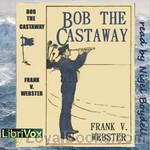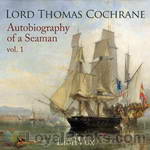|
Books Should Be Free Loyal Books Free Public Domain Audiobooks & eBook Downloads |
|
|
Books Should Be Free Loyal Books Free Public Domain Audiobooks & eBook Downloads |
|
Sea Stories |
|---|
|
Book type:
Sort by:
View by:
|
By: James Brendan Connolly (1868-1957) | |
|---|---|
 The Trawler
The Trawler
The Trawler is a short story revolving around the trying life of a group of bank fishermen based in Gloucester. Skipper Hugh Glynn worked his men hard; some said too hard, and Arthur Snow was one who had paid the ultimate price.Arthur's close friend Simon Kippen decided he'd ask to take the place of his fallen friend aboard Hugh Glynn's vessel as a dory mate, and from there we have a tale of the open seas between Gloucester and Newfoundland where perhaps only the names and locations have changed from the countless stories of similar nature; the key being that this one, however, is first hand. | |
By: Richard Henry Dana, Jr. (1815-1882) | |
|---|---|
 Two Years Before the Mast
Two Years Before the Mast
| |
By: Edward Everett Hale (1822-1909) | |
|---|---|
 Man Without A Country And Other Tales
Man Without A Country And Other Tales
Edward Everett Hale (1822 – 1909) was an American author, historian and Unitarian clergyman. Hale first came to notice as a writer in 1859, when he contributed the short story "My Double and How He Undid Me" to the Atlantic Monthly. He soon published other stories in the same periodical. His best known work was "The Man Without a Country", published in the Atlantic in 1863 and intended to strengthen support in the Civil War for the Union cause in the North. Though the story is set in the early 19th century, it is an allegory about the upheaval of the American Civil War... | |
By: John Howell (1788-1863) | |
|---|---|
 The Life and Adventures of Alexander Selkirk
The Life and Adventures of Alexander Selkirk
This work was the true story of Alexander Selkirk (1676 to December 13, 1721), a Scottish sailor who was employed in a number of different trades during his early life. As a young man, Selkirk learned the skills of tanning and shoemaking, and later became a buccaneer (a government-sanctioned pirate) on the Cinque Ports, working his way up to the position of ship's sailing master or navigator. But in the case of Selkirk, his experiences would eventually help him to survive his isolation on a deserted island in the Juan Fernández archipelago, off the coast of Chile, where he spent 52 months before being rescued... | |
By: John C. Hutcheson (1840-1897) | |
|---|---|
 The Ghost Ship
The Ghost Ship
This book intentionally veers in and out of the supernatural, as the title implies. The officers get more and more bewildered as they work out their position, and yet again encounter the same vessel going in an impossible direction. Having warned you of this, I must say that it is a well-written book about life aboard an ocean-going steamer at about the end of the nineteenth century. | |
By: Robert Louis Stevenson and Lloyd Osbourne (1850-1894) | |
|---|---|
 The Ebb-Tide
The Ebb-Tide
Three men down on their luck in Tahiti agree to ship out on a vessel whose officers have died of smallpox. Their desperate venture inspires them to a further idea: they will steal the schooner and its cargo of champagne, sell them, and live a plentiful life. The thought is intoxicating... and so is the cargo, which they sample. Inattention nearly brings them to grief in a sudden storm. This sobering experience is followed by another - apparently the dead officers had a similar ambition! - and their dreams of riches vanish... | |
By: H. De Vere Stacpoole (1863-1951) | |
|---|---|
 Beach of Dreams
Beach of Dreams
Two sailors, Harbutt and Raft, discuss their plight as workers under the thumb of a wealthy owner. During a windstorm, Raft and his fellow hands must climb a mast of the three-master to control a rigging gone astray. Once they master that runaway rigging, they pause to watch another vessel in the distance. It's a ship many have seen before. We are introduced to the occupants of this new ship, the Gaston de Paris. The owner is Prince Selm, who loves the finest things in life, yet is drawn to the sea... | |
By: Frank V. Webster | |
|---|---|
 Bob the Castaway
Bob the Castaway
Frank V Webster was a pseudonym controlled by the Stratemeyer Syndicate, the first book packager of books aimed at children. This pseudonym was used on books for boys from the early 1900s through the 1930s.Bob the Castaway follows the antics of young prankster Bob Henderson, his parents futile attempts to get him to mend his ways, and his subsequent nautical adventures. (Introduction by Nigel Boydell) | |
By: Mrs. O. F. Walton (1849-1939) | |
|---|---|
 Saved at Sea
Saved at Sea
Alick was born in a lighthouse during a storm, and raised in the same lighthouse. He used to wish something would change, and one day something did. In an attempt to rescue a ship in distress, Alick and his grandfather end up with a baby girl. Who are her parents? Did they perish on that stormy night? As the lighthouse people try to find the answers to these questions, little "Timpey" begins to work her way into their hearts. And while the lighthouse stands firmly on the rock, are Alick and his grandfather truly anchored on the Rock? | |
By: James Brendan Connolly (1868-1957) | |
|---|---|
 The U-Boat Hunters
The U-Boat Hunters
The author takes the listener on a tour of various ships used in WW1. He discusses the boats and the seamen who occupy them and their encounters with the German U-boats. It is a collection of short stories, each one complete, about them all. The author was also an Olympic athlete; winning a bronze, silver and gold medal in the Athens Olympics of 1896 and a silver in the Paris games of 1900. | |
By: Mary Seacole (1805-1881) | |
|---|---|
 Wonderful Adventures of Mrs. Seacole in Many Lands
Wonderful Adventures of Mrs. Seacole in Many Lands
I should have thought that no preface would have been required to introduce Mrs. Seacole to the British public, or to recommend a book which must, from the circumstances in which the subject of it was placed, be unique in literature. If singleness of heart, true charity, and Christian works; if trials and sufferings, dangers and perils, encountered boldly by a helpless woman on her errand of mercy in the camp and in the battle-field, can excite sympathy or move curiosity, Mary Seacole will have many friends and many readers... | |
By: William Clark Russell (1844-1911) | |
|---|---|
 Marriage at Sea
Marriage at Sea
Herbert Barclay is desperately in love with Grace Bellassys, but a number of factors stand in the way of their happiness, the biggest of which is the person of Lady Amelia Roscoe, Grace's guardian. Lady Amelia has several objections to the union, one of which is the fact that Herbert is not a Papist, and to separate the two young people, she has sent Grace to school in France. The two decide to elope, but this is just the start of the adventure... | |
By: Thomas Hood (1799-1845) | |
|---|---|
 Workhouse Clock
Workhouse Clock
There were scarcely any events in the life of Thomas Hood. One condition there was of too potent determining importance—life-long ill health; and one circumstance of moment—a commercial failure, and consequent expatriation. Beyond this, little presents itself for record in the outward facts of this upright and beneficial career, bright with genius and coruscating with wit, dark with the lengthening and deepening shadow of death. | |
By: Anonymous | |
|---|---|
 Eirik the Red's Saga
Eirik the Red's Saga
In this saga, the events that led to Eirik the Red’s banishment to Greenland are chronicled, as well as Leif Eirikson’s discovery of Vinland the Good (a place where wheat and grapes grew naturally), after his longboat was blown off-course. By geographical details, this place is surmised to be present-day Newfoundland, and is likely the first European discovery of the American mainland, some five centuries before Christopher Columbus’s journey. | |
By: Aaron Smith (?-1862) | |
|---|---|
 The Atrocities of the Pirates
The Atrocities of the Pirates
In 1822, Aaron Smith, a young English seaman, was taken captive by Cuban pirates when his ship was boarded en route from Jamaica to England. Forced to work as a navigator and as a member of pirate boarding parties, he witnessed unspeakable acts of murder and torture. Befriended by a young Cuban woman, he managed to escape with his life, but was arrested as a pirate in Havana and sent back to England in chains. There, he found himself on trial for his life at the Old Bailey courthouse—with the attorney general himself leading the prosecution. Smith's dramatic account of his personal experience is a brutally honest, unromanticized [sic] look at piracy in the 19th century. | |
By: Owen Wister (1860-1938) | |
|---|---|
 The New Swiss Family Robinson
The New Swiss Family Robinson
A parody of its famous predecessor, this short piece was written by Owen Wister for the Harvard Lampoon | |
By: Harriet Beecher Stowe (1811-1896) | |
|---|---|
 The Pearl of Orr's Island
The Pearl of Orr's Island
Go on a journey to the coast of Maine and immerse yourself in the picturesque community on Orr’s Island. See the raindrops glistening on the pine needles and hear the waves crashing on the rocks. This is a tale of romance, tragedy, crusty sea captains, an impetuous boy, a loving girl, complete with village gossips and twists in the plot. | |
By: Lord Thomas Cochrane (1775-1860) | |
|---|---|
 Autobiography of a Seaman, Vol. 1
Autobiography of a Seaman, Vol. 1
This two volume work is the autobiography of Lord Cochrane, a naval captain of the Napoleonic period. His adventures are seminal to the development of naval fiction as a genre. Marryat sailed with Cochrane, while later writers borrowed incidents from this biography for their fictions. Most notable among these is Patrick O'Brian, three of whose novels have clear parallels to incidents in the life of Cochrane. This first volume covers Cochrane's earlier life, during which he is most active militarily. (Introduction by Timothy Ferguson) | |
By: John Masefield (1878-1967) | |
|---|---|
 Selected Public Domain Poems
Selected Public Domain Poems
Maritime and metaphysical verse by John Masefield, English poet and author, Poet Laureate of the United Kingdom from 1930 until his death. | |
By: Jules Verne (1828-1905) | |
|---|---|
 Adventures of Captain Hatteras, Part 1: The English at the North Pole
Adventures of Captain Hatteras, Part 1: The English at the North Pole
The novel, set in 1861, describes adventures of British expedition led by Captain John Hatteras to the North Pole. Hatteras is convinced that the sea around the pole is not frozen and his obsession is to reach the place no matter what. Mutiny by the crew results in destruction of their ship but Hatteras, with a few men, continues on the expedition. ( Wikipedia) | |
By: William Clark Russell (1844-1911) | |
|---|---|
 Mystery of the 'Ocean Star' - A Collection of Maritime Sketches
Mystery of the 'Ocean Star' - A Collection of Maritime Sketches
This is a collection of short stories of mystery and romance, set at sea, in the times of the great sea voyages. | |
By: Various | |
|---|---|
 Sea Stories
Sea Stories
Most of us have passed through a period of life during which we have ardently longed to be, if not actually a rover, a buccaneer, or a pirate, at least and really a sailor! To run away to sea has been the misdirected ambition of many a youngster, and some lads there are who have realized their desire to their sorrow. The boy who has not cherished in his heart and exhibited in his actions at sometime or other during his youthful days, a love of ships and salt water, is fit for—well, he is fit for the shore, and that is the worst thing a sailor could say about him! (From the introduction, by Cyrus Townsend Brady) | |
By: Lucy Maud Montgomery (1874-1942) | |
|---|---|
 Watchman and Other Poems
Watchman and Other Poems
While L. M. Montgomery is better known for her novels, such as Anne of Green Gables and Emily of New Moon, she also wrote hundreds of poems. Her love of beauty, nature, and the sea is evident in this, the only volume of her poetry published during her lifetime. | |
By: Lindsay Anderson (1841-1895) | |
|---|---|
 Cruise in an Opium Clipper
Cruise in an Opium Clipper
Eamont was an opium clipper built in Cowes. It was the subject of an 1891 book, A cruise in an opium clipper, by Captain Lindsay Anderson. Eamont was involved in the opening of Japan to foreigners in 1858, serving as a dispatch boat between Nagasaki and Shanghai, and was one of the first vessels to open up a trade with Formosa…. The Eamont was sent on some very dangerous trips. She was one of the first vessels to open up a trade with Formosa, and made the first survey of the port of Taku, which she entered by bumping over the reef in spite of a tremendous surf beating upon it at the time, a most daring performance... | |
By: Herman Melville (1819-1891) | |
|---|---|
 Mardi Vol. 1
Mardi Vol. 1
"Not long ago, having published two narratives of voyages in the Pacific, which, in many quarters, were received with incredulity, the thought occurred to me, of indeed writing a romance of Polynesian adventure, and publishing it as such; to see whether, the fiction might not, possibly, be received for a verity: in some degree the reverse of my previous experience...This thought was the germ of others, which have resulted in Mardi" . | |
By: George Gibbs (1870-1942) | |
|---|---|
 In Search of Mademoiselle
In Search of Mademoiselle
Preface note by George Gibbs: There were no more vivid episodes in the colonization of the New World than those resulting from the attempts of the French people to gain a permanent foothold on our shores.... The most thrilling chapter in all this history, strangely neglected or overlooked by the romantic writers, is that of the struggle between the Spanish and French colonists for dominion over our own land of Florida. To me, whose profession it is to see pictures in the words of other men and... | |
By: William Clark Russell (1844-1911) | |
|---|---|
 Phantom Death and Other Stories
Phantom Death and Other Stories
This is a book of remarkable nautical ghost and horror stories written by William Clark Russell in 1893. The stories are for the most part set on ships and bring the reader on board for ghostly nights, wonderful sights, and strange occurrences. | |
By: Johan Bojer (1872-1959) | |
|---|---|
 Last of the Vikings
Last of the Vikings
In a small village on the coast of Northern Norway lives the Myran family. Father is a fisher man and is, in the eyes of the oldest son, like a god on the sea. Mother spends every winter in fear of losing somebody she loves to the storms and waves. She longs to move inland and turn her back on the coast and all its dangers. The novel explores some of the tension between inland and coast, poor and wealthy, tradition and progress while also depicting the highs and lows of a winter of fishing in Lofoten. - Summary by kathrinee | |
By: William Clark Russell (1844-1911) | |
|---|---|
 My Danish Sweetheart Volume 1
My Danish Sweetheart Volume 1
Young Hugh Tregarthen has grown up in a seafaring Cornish family, but is not born to follow the family tradition. Against his mother's wishes, he is coxswain of a lifeboat -- an important job along the treacherous coastline, which makes his mother proud, despite her misgivings. One morning, as he sets out for his boat Janet, invalid Mrs. Tregarthen warns her son of an ominous dream she had the previous night. He laughs it off... but sometimes, dreams come true. - Summary by Lynne Thompson | |
By: Frederick Thomas Jane (1865-1916) | |
|---|---|
 Blake of the "Rattlesnake"
Blake of the "Rattlesnake"
Fred Jane, who later went on to publish his famous "Jane's Fighting Ships", doubtless was noting the success of other books that forecast a British defeat in the event of war in the late 19th century when he wrote this fictional account of "The Man Who Saved England." Jane tells of a possible war against both France and Russia with plenty of verve and derring-do amid naval battles, both small and large. - Summary by Mark | |
By: Herman Melville (1819-1891) | |
|---|---|
 Billy Budd
Billy Budd
Young naive sailor Billy Budd is impressed into military service with the British navy in the 1790s, framed for conspiracy to mutiny, summarily convicted in a drum-head court martial, and hanged. Billy Budd is the final published work by Herman Melville, discovered in his personal papers three decades after his death. | |
By: Thomas Wallace Knox (1835-1896) | |
|---|---|
 Captain John Crane, 1800 - 1815
Captain John Crane, 1800 - 1815
John and David grew up best of friends, outgoing and full of adventure. Living but miles from the sea west of Boston, right on the cusp of manhood at the end of America’s Revolutionary war, the ocean’s siren song beckoned to both. At the peak of adolescence, they struck out on foot in pursuit of their shared dream. Two days to Boston and only one day there found them aboard ship for a whirlwind of adventure beyond their wildest dreams. The next fifteen years shaped a future for the fledgling mariners that seems spun as a flaxen yarn --- were it not so historically accurate. - Summary by Tom Hirsch | |